Sept 2004
A Dynamic Online Chapter for Barney's Book
AutomatedBuildings.com |
[an error occurred while processing this directive]
(Click Message to Learn More) |
I am pleased to present this dynamic chapter to
Barney Capehart's new book.
"Web Based Energy
Information and Control Systems - Case Studies and Application"
This chapter as well
as being in print in the book also lives as a dynamic document on our
AutomatedBuildings.com web site. Its intent is to provide more perspective on
the topics covered by the book. We provide a short abstract of the related
articles published on our web site with direct linkage to the actual articles so
you can gain more information. The web-based media is the message and it
is hoped that providing web access to this information will amplify the power of
the book and allow access to related information that has only been published
electronically to date. This new book is a squeal to the first for our industry
Information
Technology Basics for Energy Managers and Facilities Managers I have been
amazed and impressed with the widespread recognition of the need for a
comprehensive, yet basic and readable book that introduces this topic in a way
that is understandable to the average person working in the energy and facility
management area that is not an IT trained professional. Barney L Capehart, PhD,
CEM Professor Emeritus College of Engineering University of Florida
This dynamic chapter is organized into four sections:
1. Online information on Web
Based Energy Information and Control Systems
2. Evolving Communication Standards
and Protocols
3. Wireless's Rapid Evolution
4. Learning more about Web Based
Control
All sections provide
a brief abstract and
links to the full article posted on our web site. Once you are online
interacting with this chapter of the book you will better understand.
1. Online information on
Web Based Energy Information and Control Systems
Transforming the U.S. Electricity System
Rob Pratt, Pacific Northwest National
Laboratory
Presented at “Bringing the Electricity System into the Information Age”
symposia, Feb/04
 Over
the last decade, leading-edge industries have been using real-time information,
e-business systems and market efficiencies to minimize the need for inventory
and infrastructure while maximizing productivity and efficiency. However, the
energy system has yet to make those advancements, or reap their benefits. The
electric power grid is full of massive and expensive infrastructure that is
generally underutilized. To meet growing demand, utilities continue to put up
more iron and steel, and pass the cost on to their customers, who have little
say in the matter. To meet the load growth projected by the U.S. Energy
Information Agency, $450 billion of new electric infrastructure must be added by
2020 if we continue this “business-as-usual” approach.
Over
the last decade, leading-edge industries have been using real-time information,
e-business systems and market efficiencies to minimize the need for inventory
and infrastructure while maximizing productivity and efficiency. However, the
energy system has yet to make those advancements, or reap their benefits. The
electric power grid is full of massive and expensive infrastructure that is
generally underutilized. To meet growing demand, utilities continue to put up
more iron and steel, and pass the cost on to their customers, who have little
say in the matter. To meet the load growth projected by the U.S. Energy
Information Agency, $450 billion of new electric infrastructure must be added by
2020 if we continue this “business-as-usual” approach.
Request for Participation - Summer 2004 - Automated Demand
Response Test for Large Facilities
Lawrence Berkeley National Laboratory (LBNL) is
recruiting energy and facility managers of large facilities to participate in
the 2004 Automated Demand Response (Auto-DR) research project. This project
builds on the methods used in LBNL’s 2003 Auto-DR tests.
Background: The California Energy Commission
and LBNL are studying the ability of facilities to reduce electricity demand
temporarily through implementation and testing of Auto-DR. Auto-DR is being
evaluated in terms of its potential to flatten out the grid load shape on peak
days, help avoid blackouts like those that occurred in California (2001) and the
Northeast (2003), and lower costs to ratepayers. Demand response has been
identified as an important element of the State of California’s Energy Action
Plan, which was developed by the California Energy Commission (CEC), California
Public Utilities Commission (CPUC), and Consumer Power and Conservation
Financing Authority (CPA).
 …
merging Information Technology and Energy
…
merging Information Technology and Energy
In recent years EUN has
postulated many variations on the energy industry future. This discussion
defines energy future as “Gridwise”, a topic that will recur as EUN chronicles
the new development. Gridwise refers to the national electricity system and
architecture addresses information technology, networking and the Internet.
Gridwise is an initiative to stimulate development and adoption of an
intelligent energy system that enables more effective use of the U.S. Electric
System. This will result in significant opportunities for energy efficiency, but
of equal importance it can result in a more reliable Grid. Gridwise is being
sponsored by the new Department of Energy Office of Electricity Transmission and
Distribution (DOE O-ETD). It is the first new office created within the DOE in
years, which demonstrates the importance of this issue. Pacific Northwest
National Labs has acted on behalf of DOE to select a team of national experts
for the Gridwise Architecture Board. EUN readers will be able to stay informed
on Gridwise through this author, who has been invited to sit on the Board.
Vykon Energy – A Platform for Demand
Response
Along with the challenges created by deregulation,
The Department of Energy (DOE) has estimated that the demand for electricity
will grow by approximately 2% annually through the year 2020. Other countries
will be experiencing similar or higher growth rates as their economies become
more reliant on energy. Unfortunately, as demand for energy goes up, generation
units are reaching their plant maturity and being retired. In fact, almost half
of the current generating capacity in the U.S. originates from units approaching
their maturity. Although new generation continues to go online each year,
hundreds of thousands of megawatts of capacity (368,000 MW in the U.S1
.) will soon be taken off line. Constructing new generation is difficult and, in
many cases, units approved for construction have been deserted due to either
unfavorable market conditions or the “Not In My Back Yard” (NIMBY) syndrome. As
a result, generation growth cannot keep pace with demand.
"Do-it-yourself" energy information systems in a Web-based world
Manufacturers of metering products have introduced new metering and data
collection products that allow any electrical contractor or building owner to
provide Web-based energy information to customers and tenants cost-effectively.
Owners
and managers of commercial and institutional properties are increasingly
challenged to maintain profit margins in the face of high vacancy rates and more
competition for tenants. This competitive pressure, combined with volatility in
energy rates and the specter of deregulation in the electric industry has
resulted in a rapidly growing demand for more timely and accurate energy
information. Historically, getting this type of information has been expensive
and the installation of energy information systems has been left to specialists
such as systems integrators or building automation contractors. In response to
the growing demand in this market, manufacturers of metering products have
introduced new metering and data collection products that allow any electrical
contractor or building owner to provide Web-based energy information to
customers and tenants cost-effectively.
Why Connections to Our Clients' Web-Based Enterprise Are Important
Our clients' business models are evolving to enterprise based solutions as the
easiest and lowest cost way of doing business.
I
am often asked "why is web-based enterprise control so important?" I answer that
all our clients' business models are evolving to enterprise based solutions as
the easiest and lowest cost way of doing business. We have several great
articles written by industry experts for our AutomatedBuildings.com web site on
this exact topic and rather than inflicting you with my opinions and words, I am
going to provide you with three direct extracts that I feel provide great
insight to this matter
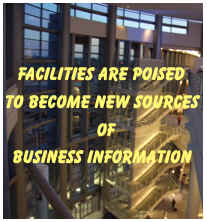 Facilities
Are Poised To Become New Sources of Business Information Automation vendors
can now play by the same rules as IT and use modern integration technologies to
transform the closed languages of their automation systems into the open and
pervasive integration languages of IT.
Facilities
Are Poised To Become New Sources of Business Information Automation vendors
can now play by the same rules as IT and use modern integration technologies to
transform the closed languages of their automation systems into the open and
pervasive integration languages of IT.
Building automation and
controls manufacturers recognize the unique needs of property managers and are
beginning to acknowledge the power of XML Web Services to provide seamless, open
interoperability between automation systems and corporate business applications.
XML Web Services, the same powerful integration framework that has been embraced
by software providers and IT departments everywhere, is also perfectly suited to
transform facility sub-systems into valuable sources of new business
information.
Networked Building Control Enhances Demand Responsiveness The convergence
of IT and building systems technology has produced secure, cost-competitive
products that are more effective for demand response than non-networked
control.
The
proliferation of the Internet and information technology (IT) hasn't stopped at
the outside of buildings--it's actually changing the way that buildings are
operated. Facility managers and energy service providers (ESPs) are beginning to
reap the benefits of networked building control--the practice of integrating
building management systems (BMSs) with corporate intranets or the Internet. One
of the main advantages of networked systems is that facility managers can
control the operation of buildings scattered across a campus or across the U.S.
It's no longer necessary to physically travel to numerous buildings to control
equipment. And because these networked building systems are easier to use,
facility managers are more likely to detect equipment problems before a total
failure can occur.
Energy 2004 - Are we really on line? What has been heralded by the
Buildings and Energy Industry as Convergence, System Integration and Internet
Digital Control™ is in direct alignment with trends in E-business as a whole
The
title of this column may seem to ask a silly question. Particularly for those
who attended the recent AHR Expo or attended the XML Symposium in January. XML
(Extensible Markup Language) may be a new term to many readers, and there is
good reason for that, it is a fairly high-level software tool that the average
user would not see. What is more important than the tool itself is the impact
that its use will have on the energy business. For those who did not hear about
the XML event, it was a world-class gathering, sponsored by the Continental
Automated Building Association (CABA) www.caba.org
and Clasma www.clasma.com, the sponsor of
BuilConn. The XML symposium presented a unique opportunity to meet with industry
leaders and talk about Internet based applications that will define the future
of the energy and buildings industry. Again, XML is a software tool being used
to develop Internet services that shape building automation and energy
management over the next decade. But before getting too far down the road, it is
worthwhile to stop and reevaluate the energy industry in the context of
Information Technology at large. This would entail revisiting the basic premise
for Energy Online, and the accompanying chart provides an excellent context for
that discussion. This chart was developed by Gartner, Inc. a business and market
analysis think tank, with operations worldwide.
A Wake-Up Call and a Brainer
Ask any
economist worth his salt what the total impact on American industry would be if
our gross use of energy were to decrease by 15% over the next 10 years.
Anyone involved
with development, design, construction or operations of commercial or industrial
facilities will tell you that automation is an absolutely essential component of
a successful energy conservation / management plan. But ask any member of that
group how many facilities under 50,000 GSF have any level of automation and the
answer is probably very few. Below 5,000 GSF, almost non-existent. You would
have to look long and hard to find a million plus GSF facility without a
building automation system. I am not talking about time clocks here. I am
talking about automation systems capable of performing fairly sophisticated
functions that would include interaction with external systems using the latest
technology. The simple reasons for this are cost and complexity. Your basic Mom
& Pop deli, the local dentist, the branch bank or the retail proprietor will
only be able to afford automation if it comes to them in the form of an embedded
appendix of those products they rely on to conduct their basic business. Their
HVAC, refrigeration and lighting systems etc. Oh, and by the way, the man
machine interface and networking of these devices to an IP connection will need
to be as simple as unpacking the box, connecting the 110 and Internet. Local
connectivity to the individual appliances and systems will almost certainly be a
wireless solution.
 Ending
the Blackout Blues We need (REALLY need) to improve the way our industry
delivers more advanced technologies to our building construction projects.
Ending
the Blackout Blues We need (REALLY need) to improve the way our industry
delivers more advanced technologies to our building construction projects.
The experts are only half
right. What they are missing is the second and equally important cause of this
tragic event. The truth is, the same type of outdated industry structure and
practices plague the energy conversion industry that operates on the building
side of the electric meter - our HVAC industry. And our industry's failure to
come to grips with it has resulted in HVAC electric energy use to be about
double what is easily achievable, making our industry every bit as responsible
for this tragedy as the utilities. That we have not yet had to bear the blame is
a gift, and should be seen as a wakeup call of our own - that we need (REALLY
need) to improve the way our industry delivers more advanced technologies to our
building construction projects. And perhaps we can do so if we can avoid the
glare of publicity while we work to more efficiently utilize the increasingly
precious energy resources available. It won't be a simple process, but I'd like
to cite here two simple things all of us can do right now that will most
certainly move us in the direction of real improvement.
Protection during Electrical Outages; Power Quality Everyday Electrical
Power Quality changes hourly, these changes affect nearly every system's
reliability in your facility and the bottom line of your business.
While most are concerned
about "the other" electrical service issue, Power Reliability (e.g. power
outage), the occurrence of such an event is infrequent as compared to Power
Quality changes. An outage does have an extended negative effect on your bottom
line however, one that is beyond the loss of productivity during the period of
the outage. This extended negative effect has to do with the damage to computer,
network, building automation, process control and many other systems. This type
of damage can be immediate but often is not; it appears in the hours and days
after a power outage event but can be prevented with the proper Power Quality
device.
If Buildings Were Built Like Cars - The Potential for Information and
Control Systems Technology in New Buildings Barney L. Capehart, University of
Florida Harry Indig, KDS Energy, Lynne C. Capehart, Consultant
The purpose of this paper
is to compare the technology used in new cars with the technology used in new
buildings, and to identify the potential for applying additional technology in
new buildings. The authors draw on their knowledge of both new cars and new
buildings to present a list of sensors, computers, controls and displays used in
new cars that can provide similar and significant opportunities for our new
buildings. Some thoughts on how this new technology could be integrated into new
buildings are also discussed. The authors hope that calling attention to using
new car technology as a model for new building technology will stimulate
recognition of the potential for new buildings, and ultimately lead to the
implementation of similar technological improvements in new buildings.
2. Evolving
Communication Standards and Protocols
LonWorks and BACnet System Solution on a Chip Both
protocols have become well established and manufacturers are working to offer
building systems supporting both platforms.
The
building control market is at the edge of major growth. It is being steered by
the recent upturns in the economy and the desire for more control of buildings
for the purpose of better optimization of energy, better service for the
customer and added security. To respond to these new market opportunities
companies are working on standard building control products based on LonWorks
ANSI/EIA-709.1 and BACnet ISO
16484-5 protocols. Both protocols offer interoperability of products
between manufacturers. The industry can now focus on two major platforms instead
of 15 or so proprietary platforms. At one time there were major battles to see
which protocol would win out in the industry. It is becoming clear that both
protocols have become well established and manufacturers are working to offer
building systems supporting both platforms.
oBIX Building Blocks
Simple modules. Complex modules. Each self
contained. Each with a well-defined interface for interoperability.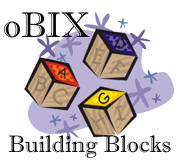
Best practices
in software systems today is to develop smaller modules, each provably able to
perform its limited internal functions and operations correctly. These systems
interact with other modules through well defined, highly abstracted and loosely
coupled interfaces, not intimate programming interactions. There are three very
big effects of this approach.
-
Each
module can be swapped out or upgraded for enhanced performance of its single
function without re-developing the entire system.
-
Functional
modules can be distributed not only across computer systems, but across
corporations, as modern ERP systems span logistical chains across companies,
countries, and continents; this is done without committing to a single
system everywhere.
-
Downtime
in any one system does not imply downtime for all.
oBIXTM Evolves at AHR Expo Short for Open Building Information
Xchange, oBIX is an initiative to define XML and Web Services-based standards
for exchanging building systems information with each other and enterprise
systems.
That was the case with
oBIXTM at the AHR Epxo recently concluded in Anaheim. Amidst the
sunny Orange County setting of theme parks, hotels and freeways, oBIX was the
subject of much buzz, discussion, and debate. Short for Open Building
Information Xchange, oBIX is an initiative to define XML and Web Services-based
standards for exchanging building systems information with each other and
enterprise systems.
At a press conference
that coincided with the AHR Expo kickoff, oBIX chair Paul Ehrlich, Business
Development Leader, Trane, and others gave key industry editors background on
the oBIX guideline and status on oBIX developments since its germination at
BuilConn in April 2003.
Reporters and observers
heard updates on the work of four task groups; Data and Services, Security,
Network Management, and Marketing. In an effort that has become obligatory in
the early stages of any business initiative, the oBIX Marketing task group has
fashioned a vision statement to furnish clarity of purpose; building systems
working together for the enterprise.
XML Spells Connection to the Future An open letter to the Building Controls
Industry turned into a reality.
An
open letter to the Building Controls Industry turned into a reality at the
consortium's first meeting at BuilConn in Dallas. That open letter, which we ran
on the AutomatedBuildings.com website, proposed that we establish a consortium
that would work on the creation of a guideline for use of XML and Web Services
in building automation and control applications. I was able to attend this
groundbreaking meeting in Dallas and the sense of purpose and cooperation in the
room was amazing.
Let's all give special
thanks to the BuilConn folk for hosting this meeting, and to the CABA
organization for giving the newly formed consortium a home.
The first paragraph of
the open letter reads:
"The Building Controls industry has made great strides over the last 10
years in the creation of communications standards. Both BACnet and LonTalk
are now viable, commercially accepted solutions that provide owners with
open communications. Yet while we have made great progress in these areas as
an industry, there has been an emergence of a larger, more globally accepted
standard created by the world of Information Technology. In particular the
broad acceptance and ever lowering cost of Ethernet / TCP/IP / XML
communications is finding its way into our industry."
Two Separate But Very Important Industry Acronyms XML & oBIX
 XML
is widely used by the IT community and considered by many as the most
important enabling technology for the future of integrated and intelligent
buildings, XML brings to fruition the convergence of building systems and
the IT infrastructure. These IT-based technologies are drastically changing
the buildings industry as they enable cooperation between disparate
approaches to open systems, a vital issue within the industry.
XML
is widely used by the IT community and considered by many as the most
important enabling technology for the future of integrated and intelligent
buildings, XML brings to fruition the convergence of building systems and
the IT infrastructure. These IT-based technologies are drastically changing
the buildings industry as they enable cooperation between disparate
approaches to open systems, a vital issue within the industry.
"As possibly the
ultimate integration mechanism for buildings, XML will revolutionize the
buildings industry," Ron Zimmer, CABA President and CEO, said. "This
symposium will provide the HVAC professional with ample XML and Web Services
education and a practical expectation of their adoption rate within the
industry."
 Ehrlich:
oBIX stands for Open Building Information Xchange, and it is an
industry-wide initiative to define XML- and Web Services-based mechanisms to
present building systems-related information on TCP/IP networks such as the
Internet.
Ehrlich:
oBIX stands for Open Building Information Xchange, and it is an
industry-wide initiative to define XML- and Web Services-based mechanisms to
present building systems-related information on TCP/IP networks such as the
Internet.
Ethernet:
The Common Thread to Total Building Systems Integration Ease of
setup/configuration/use as well as connectivity options are key factors when
considering a device server for your building automation application.
Ethernet Made Easy
Ethernet is a low cost, high speed, widely deployed, universally accepted medium
for local area and wide area networks. Layer on top the TCP/IP protocol, the
most common office networking language (as well as the language of the Internet)
and you have the initial ingredients of an open, more easily integrated system.
Of course, no solution is perfect and Ethernet has its drawbacks. However, most
of Ethernet's weaknesses have been aptly addressed making it increasingly
accepted in scenarios where it may have been rejected in the past. For example,
critics have pointed to its lack of rugged components, non-determinism, and
vendor acceptance. But, industrial grade switches, cables and connectors
compensate for these fallbacks, and vendors are quickly adopting Ethernet as the
new communication standard.
Open Systems Standards
This is the fifth of 9 articles where we are
introducing the cost benefit for interoperability and that gained from the
procurement technique achievable with open systems and choice. This article sets
out some of my opinions, a collection of web-based technical data and then a
current market summary opinion.
The contributing editor acknowledges the following extract from a recent
Automated Logic white paper as a useful contribution to the
object-orientated programming point:
Since
BACnet and EIB objects and LonMark functional profiles are
information models and XML is a modelling language, we could express
these high level information models in XML and in so doing make them
compatible with the emerging Web services architecture. Because of
the flexibility of XML and the web services architecture, these high
level models could be expanded to include other types of
facility-related (but not necessarily building automation-related)
information. If each building automation protocol developed its own
XML model, however, we would have similar but incompatible system
models. Today’s problems of translating from one protocol to another
at the building controller level would become tomorrow’s translation
problems at the Web services level. What’s needed is a unified
system model, in XML, that can be used by any building automation
protocol.
The contributing editor suggests the oBIX initiative at OASIS is a good
thing to support but the editor also acknowledges the BACnet work in
their extension of their objects to XML ( and to KNX). What is needed is
a unified model, oBIX can achieve this task the quickest and especially
with help from BACnet such that unification at XML schema level is the
best option for the end-user and supply chain.
Building Controls and BACnet, IT and XML. A report from the BIG-NA
conference; BACnet, IT and XML are hot items.
 The
convergence of Building Controls and IT, BACnet and XML are coming, and they're
coming quick! The BACnet Interest Group - North America (BIG-NA) and the BACnet
Manufacturer's Association (BMA) jointly hosted the BACnet Conference and Expo
on October 5th, 6th & 7th, 2003 at the Kingsgate Marriott Hotel and Conference
Center, on the campus of the University of Cincinnati, Cincinnati, Ohio. The
Conference featured in-depth education, demonstrations, applications and
hand-out materials on using the BACnet building automation and control network
standard within educational institutions focusing on campus / district / and
global facilities management systems and was attended by construction and
facility managers and engineering consultants representing many colleges,
universities, and global corporations.
The
convergence of Building Controls and IT, BACnet and XML are coming, and they're
coming quick! The BACnet Interest Group - North America (BIG-NA) and the BACnet
Manufacturer's Association (BMA) jointly hosted the BACnet Conference and Expo
on October 5th, 6th & 7th, 2003 at the Kingsgate Marriott Hotel and Conference
Center, on the campus of the University of Cincinnati, Cincinnati, Ohio. The
Conference featured in-depth education, demonstrations, applications and
hand-out materials on using the BACnet building automation and control network
standard within educational institutions focusing on campus / district / and
global facilities management systems and was attended by construction and
facility managers and engineering consultants representing many colleges,
universities, and global corporations.
The Niagara Framework: Measuring up to Open What exactly is an "open
system"? What are the elements . . . ingredients . . . issues?
From the customer
perspective an open system should provide freedom of choice -- the freedom to
choose the best products, the best manufacturers, the best contractor agencies
and the best service providers. The freedom to adapt as his business needs
change, and freedom to push forward on his timetable and to adopt different
technologies as needed over time. Open technologies should help the industry
better meet the demands of its' customers. In today's markets, customers need to
be agile. Some of the enterprise's largest assets - their facilities, are not.
Agile businesses will survive the onrush of global competition, Internet
marketing, shrinking boundaries . . . whatever the future brings. Agile building
control solutions are necessary to allow these enterprises to accomplish their
goals.
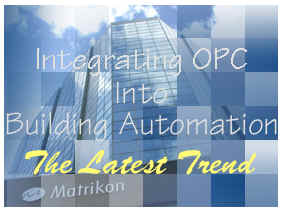 Integrating
OPC into Building Automation - The Latest Trend OPC is a viable solution
for building automation and is available today.
Integrating
OPC into Building Automation - The Latest Trend OPC is a viable solution
for building automation and is available today.
OPC is an established
standard that enables integrators to connect disparate systems together,
creating robust solutions and providing true interoperability; while at the same
time reducing implementation time and costs. In addition, OPC enables a fully
scalable solution for future changes and expansion. No longer are integrators
tied, or locked in, to a single vendor. The data has now been freed and the
ability to choose from an abundance of options is sitting well with integrators.
Integrators are now able to deploy control systems and applications, regardless
of vendor, and build best-of-breed solutions. Building automation is no longer
dominated by a few large companies. The playing field is now open for many
developers to offer far more advanced and superior solutions, while reducing the
total cost of ownership.
Protocol war yields to productive peace Ironically by narrowing the choice
of control protocols the industry can now invest more in well understood, and
supported systems that are easy to specify, install, integrate and modify.
Some business sectors
have managed to get further than the automobile industry. The IT world has the
de-facto Wintel (Windows plus Intel) standard in which (assuming you don't have
an Apple, Unix or Linux computer) you can swap files between different systems
without a problem. This standard came about by pure commercial pressure. Whether
or not you agree that a few companies should impose their technology on an
industry, there are plenty of examples, which show it to be vital to industry
and market expansion. VCRs, electricity supply, telephones and railways are
examples of innovations, which did not really begin to expand until one
technical standard rose to dominance.
What could UPnP possibly mean to Building Systems? Report from the UPnP
Summit, Cannes, France October 28/29 2003
The UPnP forum is a
voluntary, international, open organization for companies and individuals formed
in 1999. The first fact to surprise me was that here are no membership fees. The
size of the membership and who they are surprised me. Currently the 625 members
are drawn from North America, Europe and Asia. The Steering Committee is
composed of Axis Communications, Broadcom, Canon, Inc., Echelon,
Hewlett-Packard, IBM, Intel, Lantronix, LG Electronics, Metro Link, Microsoft,
Mitsubishi, Philips, Pioneer, Ricoh, Samsung, Siemens, Sony, Thomson and most
recently, Pelco.
3. Waking Up to
Wireless, Wireless's Rapid Evolution
 Waking
Up to Wireless Wireless…. WAKE UP it is here and it is
now!
Waking
Up to Wireless Wireless…. WAKE UP it is here and it is
now!
I
am writing this column just
after returning from BuilConn in Dallas. The haze of mega information is
starting to clear and I want to tell you about one of the strong trends I saw at
the show. Wireless…. WAKE UP it is here and it is now! ….. AND it will again
change the shape of our industry. Approximately 10 to 15% of the folks at the
conference were in the wireless industry. Wireless is now cheaper, runs forever
on batteries, can even be self-generating, and can now organize itself into self
healing and repeating networks. Let me provide you connection to some of the new
thinking that will appear in our building automation products in the near
future.
Wireless Mesh Sensor Networks
Enable Building Owners, Managers,
and Contractors to Easily Monitor HVAC Performance Issues
As the name
implies, wireless mesh sensor networks are:
1.
Comprised of wireless nodes. A node in
this type of network consists of a sensor or an actuator that is connected
to a bi-directional radio transceiver. Data and control signals are
communicated wirelessly in this network and nodes can easily be battery
operated.
2.
Arranged in a networking topology called “mesh”. A typical mesh
network topology is shown in Figure 1. Mesh networking is a type of network
where each node in the network can communicate with more than one other node
thus enabling better overall connectivity than in traditional hub-and -spoke
or star topologies. State of the art mesh networks often have some of the
following characteristics:
a.
They are self-forming. As nodes are powered on, they
automatically enter the network.
b.
They are self-healing. As a node leaves the network, the
remaining nodes automatically re-route their signals around the
out-of-network node to ensure a more reliable communication path.
c.
They support multi-hop routing. This means that data from a node
can jump through multiple nodes before delivering its information to a
host gateway or controller that may be monitoring the network.
The
self-forming, self healing, and battery operable attributes of a mesh sensor
network make it ideal for temporary environmental monitoring applications in a
wide range of facilities.
Autonomic Wireless Building Networks
The key to reliable ad hoc wireless networking for
building automation applications and protocols is an Autonomic mesh network: an
Autonomic network is one that self-configures, self-heals, self-regulates, and
understands when to apply these parameters.
Wireless technology for
building automation applications has developed rapidly and commodity radio
technology has helped accelerate adoption. Wireless technology provides the
benefits of wire replacement for reduced deployment and maintenance costs;
increased scalability; and has enabled application development. As pointed out
by Helmut Macht, chief technology officer for Siemens Building Technologies
Group, "The innovations in wireless communication allow more and more wired
communication to be replaced."[1] In addition, wireless is an enabler for many
hard-to-reach or hard-to-wire applications typically found in large old
buildings, museums, factory floors, and remote job sites; and also in rapidly
developing countries like China and India where the cost of wiring anything (labor,
routes through old neighborhoods, etc.) is just about cost-prohibitive.
The
ZigBee Alliance review of the ZigBee Alliance which is leading the new wave
in wireless networking.
Mission
The ZigBee Alliance is an association of companies working together to enable
reliable, cost-effective, low-power, wirelessly networked, monitoring and
control products based on an open global standard.
Objective The goal of the ZigBee Alliance is
to provide the consumer with ultimate flexibility, mobility, and ease of use by
building wireless intelligence and capabilities into every day devices. ZigBee
technology will be embedded in a wide range of products and applications across
consumer, commercial, industrial and government markets worldwide. For the first
time, companies will have a standards-based wireless platform optimized for the
unique needs of remote monitoring and control applications, including
simplicity, reliability, low-cost and low-power.
What
is GridWise? GridWise is an entirely new way to think about how we generate,
distribute and use energy. Using advanced communications and up-to-date
information technology, GridWise will improve coordination between supply and
demand, and enable a smarter, more efficient, secure and reliable electric power
system.
GridWise seeks to modernize the nation's electric
system - from central generation to customer appliances and equipment - and
create a collaborative network filled with information and abundant market-based
opportunities. Through GridWise, we can weave together the most productive
elements of our traditional infrastructure with new, seamless plug-and-play
technologies. Using advanced telecommunications, information and control
methods, we can create a "society" of devices that functions as an integrated,
transactive system.
GridWise optimizes resources by integrating all
elements of the electric system and allowing them to work together in smarter,
faster ways. Taking advantage of new and existing technologies, GridWise
integrates the energy infrastructure, processes, devices, information and
markets into a collaborative arrangement that allows energy to be generated,
distributed and consumed more efficiently.
4. Learning more
about Web Based Control
Connecting Convergence
August Supplement Engineered Systems
Connecting Convergence
In our fourth supplement
“Connecting Convergence” prepared for Engineered Systems Anto and I identify
the major trends that are fuelling the connection of real time data to our
client’s enterprise. For the most part convergence has happened and what is left
to do is sort out who will be the players and which standards will be used in
providing these essential connections. Anto’s views are well expressed in his
portion of the supplement Convergence or Divergence? Which way to Enterprise
Building management? He outlines the drivers and trends and then
analyzes what is going on to move us forward in delivering value to building
owners and operators.
Convergence
or Divergence
 While
the industry buzz in the past couple of years has been the idea of convergence,
now is a good time to review what is really going on in the industry delivering
building systems. To do this, let us look at the drivers and trends and then
analyze what is going on to move us forward in delivering value to building
owners and operators.Marketing Convergence -
Engineered Systems November Supplement
While
the industry buzz in the past couple of years has been the idea of convergence,
now is a good time to review what is really going on in the industry delivering
building systems. To do this, let us look at the drivers and trends and then
analyze what is going on to move us forward in delivering value to building
owners and operators.Marketing Convergence -
Engineered Systems November Supplement
Technology developments are clearly the most visible
driver in our industry. In the past decades we have seen the advent of DDC
(Direct Digital Control), the proliferation of networked controls and even the
creation of open system standards. These changes significantly affected the
internal workings of the industry. They provided new features, flexibility, cost
savings and even the freedom of choice between systems to control and manage a
building. They did not however, change the relationship between building systems
and the owners in any significant manner; building systems remained entities
unto themselves.
Convergence Will Happen
 In
the past we did not realize that our industry's direction and our personal lives
would be so effected by information convergence. We cannot wait until
convergence occurs and then get involved with how it gets marketed, because it
will be too late; the marketing plan will not include our industry. Our
industry's presence in creating a marketing convergence plan changes everything.
We as an industry bring new concepts and tools to the convergence table in the
form of "real time information." Our industry's business is collecting, acting
on, and distributing real time data such as temperature, pressures, energy
usage, client comfort, humidity, IAQ, video, security card ID's.
In
the past we did not realize that our industry's direction and our personal lives
would be so effected by information convergence. We cannot wait until
convergence occurs and then get involved with how it gets marketed, because it
will be too late; the marketing plan will not include our industry. Our
industry's presence in creating a marketing convergence plan changes everything.
We as an industry bring new concepts and tools to the convergence table in the
form of "real time information." Our industry's business is collecting, acting
on, and distributing real time data such as temperature, pressures, energy
usage, client comfort, humidity, IAQ, video, security card ID's.
Why Is There A Need For Marketing?
But some kind of mass
communication must occur in order for convergence in the building systems
industry to gain a stronger foothold and industry-wide acceptance. Building
owners are aware that this convergence is happening, and they're out there
looking for answers. And convergence is certainly talked about and written
about, but for the most part the message of the remarkable benefits of truly
integrated systems is still missing its target. So what does the building
systems industry need to do to be heard?
Selling Integration and Convergence
The Buildings Industry is
undergoing massive change, and its' impact on automation and engineered systems
will be profound. My conservative estimate is that 75% of today's "control
contractors" will cease to exist, or dramatically change their business model
over the next decade.
Controlling Convergence - Engineered Systems April Supplement
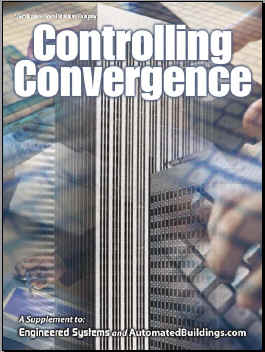 Knowledge
gained from the digital office explosion has helped building owners understand
the potential savings of cost effective web-based upgrades to insure and
communicate client comfort at the lowest energy and manpower costs. These
solutions are being applied to new buildings but attractive paybacks are also
available with the upgrading of existing DDC automation to web-based solutions.
Moving to the next level of advanced digital buildings for owners is achievable
now because of our automation industry's present position, which includes a
myriad of web-based solutions. This position allows us as an industry to lead
the world's dynamic/interactive data integration revolution. Working examples
now available are Dynamic Energy Control/Accounting, Indoor Air Quality
Reporting, Client Comfort Communication & Control interfaces. The transforming
of our conservative large building automation industry is necessary to increase
our visibility to building owners, designers and decision makers. This new
visibility is forcing us to reinvent, restructure and repackage ourselves to
create an exciting identity that will make web-based information and real time
interactions come alive with seamless connections to the clients' enterprise.
Knowledge
gained from the digital office explosion has helped building owners understand
the potential savings of cost effective web-based upgrades to insure and
communicate client comfort at the lowest energy and manpower costs. These
solutions are being applied to new buildings but attractive paybacks are also
available with the upgrading of existing DDC automation to web-based solutions.
Moving to the next level of advanced digital buildings for owners is achievable
now because of our automation industry's present position, which includes a
myriad of web-based solutions. This position allows us as an industry to lead
the world's dynamic/interactive data integration revolution. Working examples
now available are Dynamic Energy Control/Accounting, Indoor Air Quality
Reporting, Client Comfort Communication & Control interfaces. The transforming
of our conservative large building automation industry is necessary to increase
our visibility to building owners, designers and decision makers. This new
visibility is forcing us to reinvent, restructure and repackage ourselves to
create an exciting identity that will make web-based information and real time
interactions come alive with seamless connections to the clients' enterprise.
Tom responded with a
powerful article, which we have included in this supplement called
"Convergence: What Is It, What Will It Mean, And When Will It Happen?"
Over
the last several years, a remarkable transition has begun in the building
controls industry. We see it in what are called Web based control systems that
permit operation over standard Web Browsers. In itself, a Web based system is
not really much to be excited about. User-friendly human interfaces for building
controls have been around a long time. The only real direct advantage of a Web
based control interface is that because it uses standard Web browser software,
no special software package is required for a computer to operate as a human
interface terminal for the control system. Very few control systems really use
more than a couple of human interface terminals anyway, so many in the industry
are asking, "What's all the fuss about?"
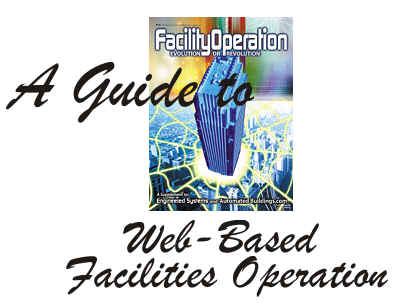 Facility
Operation Evolution or Revolution
Guide to Web-Based Facilities Operations - Doing more with less by using
Web-based anywhere information to amplify your existing building operational
resources.
Facility
Operation Evolution or Revolution
Guide to Web-Based Facilities Operations - Doing more with less by using
Web-based anywhere information to amplify your existing building operational
resources.
The creation of the new
model of data and information and support anywhere provides an excellent
opportunity to simplify and increase the ease of access to critical building
operations. As the "DDC Revolution" exposed the complex relationship between
controls and equipment the "Net Revolution" will expose our lack of
understanding of the complex cost/comfort/safety issues of today's buildings.
This will cause us to economically invest in the need for increased knowledge to
operate today's complex buildings cost effectively.
The Web-based
presentation of static and dynamic building information of what is actually
required to achieve the best of client comfort, while maintaining excellent
Indoor Air Quality for the least cost per square foot will be an eye opener for
all. As these dynamic models evolve, reflecting the realities of day-to-day
building operation, management will be required to re-evaluate the real cost of
having less than the best possible operation people; they will arrive at the
conclusion that the correct operation team can greatly add to the company's
bottom line by enhancing the art of providing desirable cost effective
buildings.
The new Web-based media
access and presentation has the power to simplify and teach while greatly aiding
the comprehension of building operations. The concept of creating a website for
each complex allows critical building information to be located in one organized
place accessible to all. The inter-weaving of the actual dynamic building
information allows contractors and consultants the ability to quickly understand
complex building problems.
Procurement of the Latest and Greatest
The request for proposal approach allows active
solicitation of the innovative approach.
The request for proposal approach
allows active solicitation of the innovative approach.
We solved this problem over 20 years ago when the Direct Digital System started
to replace pneumatic controls. The problem then was that old ways were hard to
change and to reap the benefit of these new technologies the traditional design
needed to be retrofitted as soon as the system was installed. To really capture
the power of DDC a new approach was needed. The control part of a building
represented a small fraction of the total cost and assembly was left to a
fragmented group with no concept or care to how the building owner may wish to
use the system. The solution was to follow the IT industry procurement model and
to buy the building controls much the same as an owner would buy his IT
enterprise system. In purchasing IT systems the fact that it all fit together
and worked was more important than the lowest cost. Feature, functionality and
fit ruled the procurement process.
One of our sixteen is missing … or can Integration be specified?
Integration presents
challenges to the construction procurement process on numerous levels. The
industry is demanding integration throughout the enterprise from building
automation, fire alarm, access and video surveillance for security to Enterprise
Energy Management, Metering and Maintenance Management. Integration goes beyond
independent building systems such as those listed above, because it requires
commonality with building application infrastructure including: hardwired and
wireless LANs', central databases and even network-client software among others.
In the last few months, I have reviewed more than a dozen Requests for Proposals
and Specifications asking vendors to provide systems that integrate many or all
of the above systems. Some of these have been solicitations independent of
construction and some have been part of construction specifications. Set aside
the flaws that might exist in any of these specifications because of a lack of
understanding of the independent systems themselves or the complex interaction
that must be achieved between all of these systems and the host of generations
thereof. The fundamental issue raised here is that those solicitations that are
done as part of a new construction process creates divisions between the various
trades, tasks and scopes of work to be carried out.
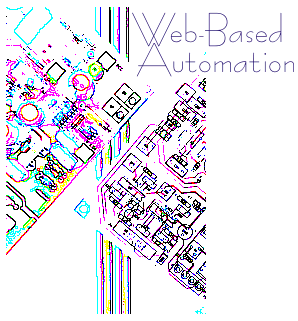 Web-Based
Automation Access to real-time information anywhere, anytime through an
Internet-enabled automation system is the real value of this technology.
Web-Based
Automation Access to real-time information anywhere, anytime through an
Internet-enabled automation system is the real value of this technology.
Automatedbuildngs.com
is a focal point for discussion of control technologies in general, and by
extension related Internet technology due to the e-zine's unique vantage point
on the industry. Having recently returned from the AHR show in Chicago it seems
appropriate to address this juxtaposition of Automation and the Internet, as it
seemed to be a significant factor every booth. "Native TCP/IP, Internet-Ready,
IP enabled and Internet Control are among the related buzzwords that were used,
along with a host of references to Web Browsers and other Internet based
features. At the same time, many attendees were asking; what does it mean and
how do you cut through the hype to see if it brings any value? The logical
expansion of building automation has been to move from Heating Ventilation and
Air Conditioning (HVAC) control to Direct Digital Control (DDC) and integration
of fire and security, and potentially more. The next step for DDC was Internet
access, but Web-based Automation or "Internet Control" goes beyond simple
access. Internet control automates facilities, HVAC and processes, while
expanding the scope of control to the enterprise level, thus using the Internet
to convert a control system into a management information system.
Energy and Wireless Internet …what's the connection? Wireless Internet is
yet one more tool to use in the continual evolution toward Real-time Energy
Management.
One
of most exciting new technologies today is Wireless Internet Service. It became
evident to me how quickly this technology is growing when my family recently
visited four Universities, all of which touted wireless Internet access. This
Internet technology is called Wireless Fidelity (WI-FI) and a recent New York
Times article noted that one can walk down any street in lower Manhattan
continually surfing the Web. WI-FI is the reason and it is so pervasive that
computers with Intel's centrino™ mobile technology or an "802.11b card" can
literally hop from one WI-FI network to another.
Real-time Energy Dashboard™ the next new thing in Building Automation
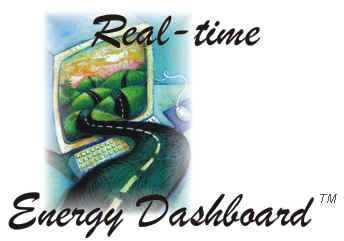 As
both author and a System Integrator this entire topic has been an ongoing focus.
The result of those efforts is a product called the Real-time Energy Dashboard™.
Please note that this is not intended to be an advertisement, but this concept
is so new that it is easiest to describe it by showing a real example, and of
course it also answers the question above. The concept of dashboards has been
growing in popularity for several years in the Information Technology business.
Much as Ken discussed in his Engineered Systems treatise, the dashboard can be,
in effect, a home page for a building. However it has the potential to be much
more! The simple fact is that there is data trapped, and sometimes hoarded, in
microcosms throughout any organization. Facility managers have data that only
they usually get to see, and so does accounting, finance, purchasing, etc. In
most cases these and other groups are more than happy to share the information
that they have, but in order to get at it a user must be proficient with special
hardware and software, as well as go to someone's office. The dashboard concept
is based upon the definition of Web Services, which simply stated is a process
that makes it possible for information to be shared between many different
systems, that was previously not shared and not available, via the Internet.
As
both author and a System Integrator this entire topic has been an ongoing focus.
The result of those efforts is a product called the Real-time Energy Dashboard™.
Please note that this is not intended to be an advertisement, but this concept
is so new that it is easiest to describe it by showing a real example, and of
course it also answers the question above. The concept of dashboards has been
growing in popularity for several years in the Information Technology business.
Much as Ken discussed in his Engineered Systems treatise, the dashboard can be,
in effect, a home page for a building. However it has the potential to be much
more! The simple fact is that there is data trapped, and sometimes hoarded, in
microcosms throughout any organization. Facility managers have data that only
they usually get to see, and so does accounting, finance, purchasing, etc. In
most cases these and other groups are more than happy to share the information
that they have, but in order to get at it a user must be proficient with special
hardware and software, as well as go to someone's office. The dashboard concept
is based upon the definition of Web Services, which simply stated is a process
that makes it possible for information to be shared between many different
systems, that was previously not shared and not available, via the Internet.
Economy Drives Convergence The first
advantage of convergence is installed cost.
The first advantage of
convergence is installed cost. It's less expensive for the BAS to use
multi-function cabling and technology already installed for other enterprise
networking applications: email, sales data, collaboration tools, and others.
What's more, enterprise networks are correctly seen as mission critical. As a
result, these networks usually are high-performance, capable of carrying a vast
amount of application data at high speed with good security and reliability.
Access and reach are
two more advantages that enterprise networks offer BAS systems. By their nature,
enterprise networks reach out to points throughout a company or institution
where a traditional BAS, until very recently, had limited or no means to
communicate. When a BAS uses an enterprise network, the BAS and its users
benefit from this expanded reach. Just as Simone in Fresno can send email with a
spreadsheet attached back to the corporate office in Toledo, the BAS in Fresno
can automatically share energy usage reports and other operating data with the
Toledo office. The corporate facilities manager now has an unprecedented ability
to keep tabs on increasingly dispersed holdings in real time, a great benefit to
controlling costs in an energy-sensitive economy.
footer
[an error occurred while processing this directive]
[Click Banner To Learn More]
[Home Page] [The
Automator] [About] [Subscribe
] [Contact
Us]
 Over
the last decade, leading-edge industries have been using real-time information,
e-business systems and market efficiencies to minimize the need for inventory
and infrastructure while maximizing productivity and efficiency. However, the
energy system has yet to make those advancements, or reap their benefits. The
electric power grid is full of massive and expensive infrastructure that is
generally underutilized. To meet growing demand, utilities continue to put up
more iron and steel, and pass the cost on to their customers, who have little
say in the matter. To meet the load growth projected by the U.S. Energy
Information Agency, $450 billion of new electric infrastructure must be added by
2020 if we continue this “business-as-usual” approach.
Over
the last decade, leading-edge industries have been using real-time information,
e-business systems and market efficiencies to minimize the need for inventory
and infrastructure while maximizing productivity and efficiency. However, the
energy system has yet to make those advancements, or reap their benefits. The
electric power grid is full of massive and expensive infrastructure that is
generally underutilized. To meet growing demand, utilities continue to put up
more iron and steel, and pass the cost on to their customers, who have little
say in the matter. To meet the load growth projected by the U.S. Energy
Information Agency, $450 billion of new electric infrastructure must be added by
2020 if we continue this “business-as-usual” approach.
 Facilities
Are Poised To Become New Sources of Business Information
Facilities
Are Poised To Become New Sources of Business Information










